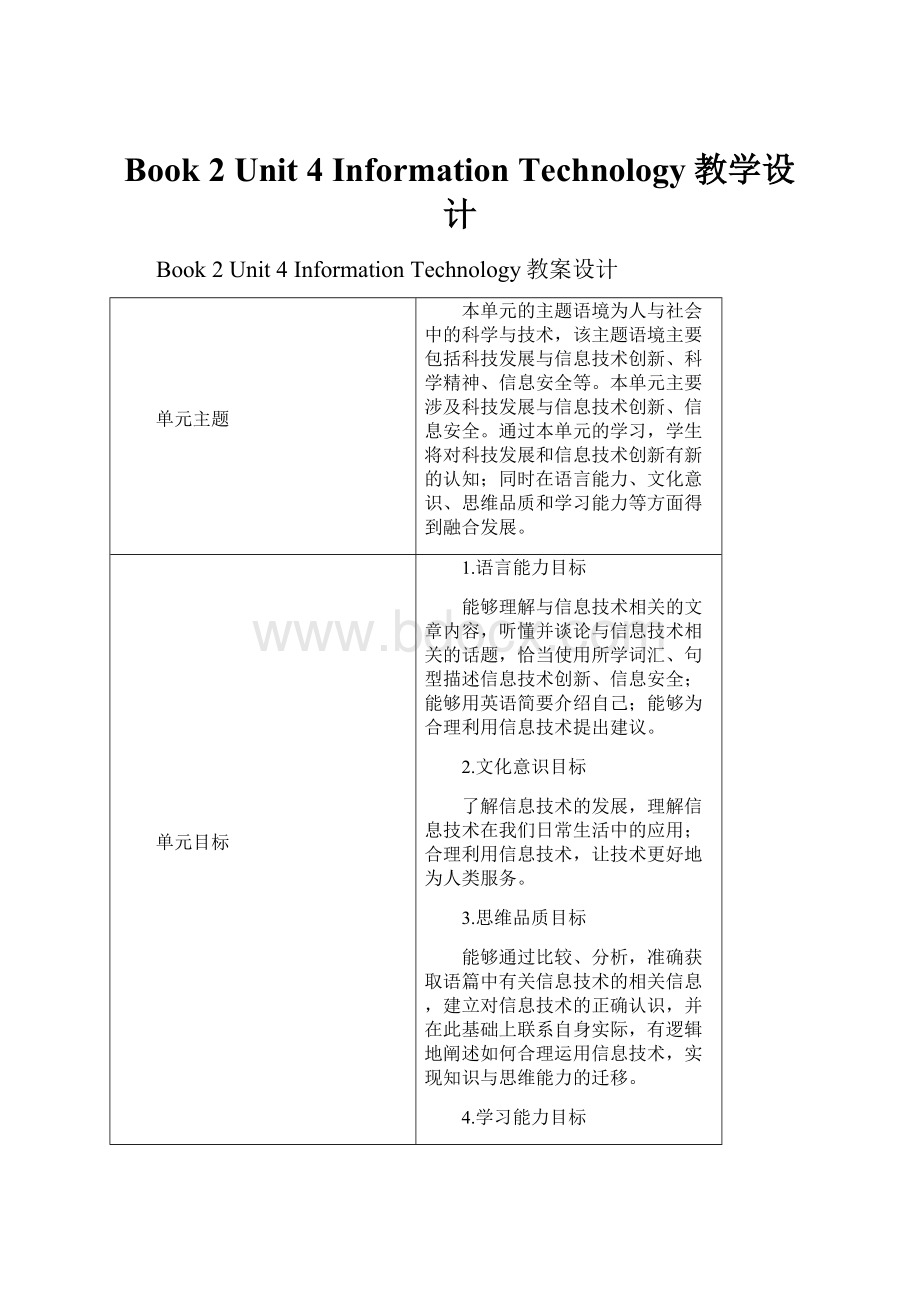Book 2 Unit 4 Information Technology教学设计.docx
《Book 2 Unit 4 Information Technology教学设计.docx》由会员分享,可在线阅读,更多相关《Book 2 Unit 4 Information Technology教学设计.docx(19页珍藏版)》请在冰豆网上搜索。

Book2Unit4InformationTechnology教学设计
Book2Unit4InformationTechnology教案设计
单元主题
本单元的主题语境为人与社会中的科学与技术,该主题语境主要包括科技发展与信息技术创新、科学精神、信息安全等。
本单元主要涉及科技发展与信息技术创新、信息安全。
通过本单元的学习,学生将对科技发展和信息技术创新有新的认知;同时在语言能力、文化意识、思维品质和学习能力等方面得到融合发展。
单元目标
1.语言能力目标
能够理解与信息技术相关的文章内容,听懂并谈论与信息技术相关的话题,恰当使用所学词汇、句型描述信息技术创新、信息安全;能够用英语简要介绍自己;能够为合理利用信息技术提出建议。
2.文化意识目标
了解信息技术的发展,理解信息技术在我们日常生活中的应用;合理利用信息技术,让技术更好地为人类服务。
3.思维品质目标
能够通过比较、分析,准确获取语篇中有关信息技术的相关信息,建立对信息技术的正确认识,并在此基础上联系自身实际,有逻辑地阐述如何合理运用信息技术,实现知识与思维能力的迁移。
4.学习能力目标
能够通过了解信息技术,激发对互联网技术的兴趣;能够多渠道获取英语学习资源;能够选择恰当的策略与方法,如听力策略、阅读策略等,监控、评价、反思和调整自己的学习内容和进程。
TopicTalk板块教学设计
(建议时长10–15分钟,教师可根据教学实际酌情调整。
)
课型
Listening+Speaking
主题语境
人与社会——科学技术
内容分析
本部分包含两段关于手机软件的音频对话材料。
一段是关于信息技术的好处以及影响;另一段是有关不同手机软件的用途。
第一段对话旨在通过谈论信息技术带来的影响,让学生对信息技术有基本的了解,进而在生活中正确运用信息技术;第二段对话旨在引导学生谈论不同手机软件的用途,让学生学会用英语描述不同的手机软件。
教学目标
1.积累并且活学活用词汇explore,convenience,impact,addicted,recommendation,avatar,personality等和信息技术有关的词汇、短语;
2.对本单元话题——信息技术,有初步的了解;
3.通过音频对话,对信息技术有一定的了解,学会在生活中正确运用信息技术;
4.谈论手机软件的用途,向别人介绍自己喜欢的手机软件。
教学重点
1.引导学生在具体语境中掌握相关短语和词汇;
2.清晰明了地介绍一些手机软件的用途。
教学难点
1.引导学生辩证看待信息技术,正确评价它所带来的影响;
2.引导学生正确对待信息技术,发挥信息技术的优势,避免沉迷网络。
教学策略
听说法
Teachingcontents
Procedures
Purposes
Teacher’sactivity
Students’activity
Activity1
1.Tpresentssomewordsandtheircorrespondingpicturesforstudentstoenjoy.
2.TasksSsseveralquestionsrelatedtoinformationtechnology.
1.Sslookatthewordstoguesstheirmeaningswiththehelpofseveralpictures.
2.Ssanswerthesequestions:
①WhatisITshortfor?
②HowisITappliedinourdaily?
WhatITsoftwarehaveyouused?
Whataretheirfunctions?
Graspsomenecessarynewwordstolayasolidfoundationforthislesson,andarousestudents’understandingofinformationtechnology.
Activity2
1.TasksSstolistthereasonswhypeopleuseinformationtechnology,theusesofinformationtechnology,andinwhatwaypeopleuseit.
2.Tplaysthetapeonthereasons,usesandeffects/impactsoftechnology.
3.Tdrawsamindmapwhichneedstobecompleted.
1.Ssbrainstormthereasonsofusinginformationtechnology,itsusagesanddifferentaspectsinwhichwemayuseinformationtechnology.
2.Sslistentothedialogueandcompleteitbyunderliningthewordsorexpressionstheyhear.
3.Sscompletethemindmapaccordingtothelisteningmaterial.
BrainstormtoopenSs’mindsandhaveabetterunderstandingofinformationtechnology.Sortoutinformationbydrawingamindmap.
Activity3
Tplaysthetapeaboutdifferentappsandtheiruses.
Sstakenotesandwritedownwhypeopleusetheseappsintermsofthelisteningmaterial.
CompletethetabletodevelopSs’abilityoflistening.
Activity4
TprovidesSswithdifferentkindsofappsandencouragesSstoexpressSs’ideastowardsthem.
Ssexpresstheirideastowardstheseapps.
PresenttopicsrelatedtoSs’dailylives,sothattheyareeagertoexpressthemselves.
Activity5
1.TasksSstointroducetheirfavoriteappstoothersingroups.
2.TencouragesSstoshowthebestappofeachgroup;
1.Ssformgroupsandintroducetheirfavoriteappstoothergroupmembers.
2.Ssintroducetheirbestelectedapptothewholeclass.
ExpressingroupscanprotectSsfrombeingshy.Thewhole-classactivitycanhelpSsexpressthemselves.
Activity6
1.TguidesSstothinkaboutstrengthsandweaknessesofinformationtechnology,andwritethemdown.
2.TplaysavideoabouthowtomakefulluseofIT.
1.SswriteaparagraphabouttheappstheyfindusefulandtheproblemstheyshouldbeawareofwhenusingInformationTechnology,andexplainwhy.
2.Ssenjoythevideoandadoptsomeviewsofthespeakerinthevideo.
Learntotreatinformationtechnologyobjectively.
Lesson1板块教学设计
(建议时长40–45分钟,教师可根据教学实际酌情调整。
)
课型
Reading+Speaking
主题语境
人与社会——科学技术
内容分析
本文是高中英语第二册Unit4InformationTechnology的第一课Avatars,课型是阅读课。
本节课主要内容是了解与现代信息技术相关的内容,讨论了我们在网络上使用的虚拟形象。
通过学习本课,使学生们了解现在信息技术的相关术语表达、含义,并培养学生阅读科技类阅读的能力。
其主题意义在于通过探讨虚拟形象的发展与功能,让学生认识到虚拟形象与人物性格及创造力的关系,并引导学生正确使用虚拟形象,提升网络社交的安全意识。
教学目标
1.通过skimming和scanning的阅读技巧,概括和提炼文章关于虚拟形象的主要信息,并且能够总结出文章每段的中心句和全文的整体段落结构;
2.积累并且活学活用词汇avatar,image,digitalidentities,personalities,Internetusers,instantmessage,virtualworlds等和虚拟形象有关的词汇、短语;
3.能够描绘虚拟形象的利弊;
4.了解并且梳理虚拟形象在不同方面对我们产生的影响;
5.反思与评价虚拟形象和人们的关系;
教学重点
1.能够运用所学对avatars进行介绍;
2.理解文章的整体篇章结构,从正反两方面对虚拟形象进行论述。
教学难点
1.总结、概括各段落中心大意;
2.根据关键信息,写出文章概要。
教学策略
P-W-P阅读模式、任务型教学法
Teachingcontents
Procedures
Purposes
Teacher’sactivity
Students’activity
Activity1
1.TpresentssomewordsandtheircorrespondingpicturestohelpSsbetterunderstandandmemorizethesewords.
2.TarousesSs’interestinthistopicbyaskingthreequestions.
Q1:
Whatisanavatar?
Q2:
Wheredoweuseavatars?
Q3:
Whatdoyouuseasanavatar?
Andexplainwhy.
1.Ssguessthemeaningsofthesenewwordswiththehelpofpictures.
2.Ssdescribeavatarswiththeirownwords,andthinkaboutwheretheyuseavatarsandwhatavatarstheyuse.
Leadtothetopicandactivateknowledge.
Activity2
TencouragesSstopredictwhataspectsofavatarsthefollowingpassagewillmention.
Ssbrainstormpossibleaspectsthatwillbeinvolvedinthefollowingpassage.Andcheckwhatarementionedandunderlinethem.
Trainstudents’skillsofpredictinganddivergingthinking.
Activity3
1.TprovidesSswithatablethatneedstobecompletedinActivity4.
2.TasksSssomequestionstothinkandanswer.
1.SscompleteActivity4.Theycanreadthepassageagainifnecessary.
2.Sssharetheiranswersandgivethereasons.
Sortoutinformationbyfillingouttheform.ActivateSs’abilityofdeepthinkingbyraisingcriticalquestions.
Activity4
1.TguidesSstodividethispassageintoseveralpartsandfindoutmeaningsofeachpart.
2.TchoosessomecomplexsentencesandguidesSstoanalyzethem.
1.Ssdividethispassageintoseveralpartsandsummarizethemeaningofeachpart.
2.Ssreadthesecomplexsentencesandjudgethekeygrammarpointsofthem.
TrainSs’skillsofgettingspecificinformationandunderstandingthelanguageofthepassage.
Activity5
1.TinvitesSstointerviewclassmatesanddoasurveyinvolvingthreequestions.
2.TencouragesSstowriteareportintermsoftheirinterview.
1.Ssinterviewtheirclassmatesandfindouttheirexperiencesrelatedtoonlineavatars.
2.Ssaccomplishthereportaccordingtotheresultoftheirinterview.
TrainSs’abilityofusinglanguageintheirreallifeandhelpthemrealizetheimportanceofonlineavatars.
Activity6
TasksSstoretellthewholepassageaccordingtoitsbasicstructure.
Withthehelpoftheoutline,Sstrytoretellthewholepassageaswellaspossible.
DevelopSs’abilityofunderstandingthewholepassageandlinkinguptheisolatedsentences.
Activity7
TpresentsSswithsomekeywords,phrasesandusagesofthem.
Sslearntograspthemeaningsandusagesofthesekeywordsandphrases,andtakepracticeinsentences.
Learnlanguagepointsincontextisaneffectiveway.
Lesson2板块教学设计
(建议时长40分钟,教师可根据教学实际酌情调整。
)
课型
Listening+Speaking
主题语境
人与社会——科学技术
内容分析
本板块包含三段听力材料。
第一段材料是对手机软件开发者的采访,分别探讨了手机软件兴起的原因,教育软件的新兴功能,开发者遇到的问题以及当下的研究;第二段材料发生在一对父子之间,父亲要求儿子帮助自己在购物网站上注册信息;第三段材料发生在顾客与客服之间,顾客要求客服帮助自己查询一个未按时收到的包裹。
二、三段材料可以
引导学生学会提出请求并给予帮助。
教学目标
1.学生能够掌握听力材料中的关键单词和短语;
2.抓住所听语段的关键词,理解话语之间的逻辑关系;
3.听懂材料中主要人物和事件,并弄懂他们之间的关系;
4.掌握较好的听力方法,听之前看问题,对答案进行预测,学会做笔记。
教学重点
1.学习并掌握文章中的关键单词和词组;
2.听短文,获取文章的关键信息,并回答问题;
3.引导学生通过听录音和回答问题对手机软件有更深入的了解,激发学生对软件开发的兴趣。
教学难点
让学生掌握正确的听力技巧,学会预测,做笔记,听关键词。
教学策略
交际教学法、听说法
Teachingcontents
Procedures
Purposes
Teacher’sactivity
Students’activity
Activity1
1.TshowsSsseveralnewwordsandtheircorrespondingpicturestohelpthembettermemorizenewwords.
2.TpresentsSswithsomefrequentlyusedappsandasksSssomequestionsrelatedtoapps.
1.Ssfindoutthemeaningsofthesenewwordsandmemorizethem.
2.Ssanswerthesequestionsaboutapps,soastolayagoodfoundationforlistening.
Backgroundinformationisessentialtounderstandinglisteningmaterials.
Activity2
1.TraisesthreequestionsandencouragesSstopredictpossibleanswerstothem.
2.Tplaysthetapeof4.3twice.
1.Ssgivetheirunderstandingofthesethreequestions.
2.SslistentotheradioandchecktheiranswerswiththehelpofSkillBuilder.
3.Sslistentotheradioagainandcompletethedetailinformation.
Predictingbeforelisteningplaysanimportantpartintheprocessoflistening.
Activity3
TguidesSstodiscusswhethertheywouldliketobecomputerprogrammersandwhattheywouldliketoachieveiftheywerecomputerprogrammers.
Sssaysomethingaboutbecomingcomputerprogrammersanddiscussthereal-worldproblemsthey’dliketosolve.
PretendtobeacomputerprogrammermayhelpSsbetterconsiderthings.
Activity4
1.TasksSstoshareanexperienceofusingappsbetweenthemandtheirparentsorgrandparents.
2.Tplaystheradioof4.4.
1.Ssworkinpairs,andtalkabouttheirexperiencesofteachingtheirparentsorgrandparentstouseapps.
2.SslistentotheradioandcompletetheTalkBuilder.
SharetheirownexperiencescanactivateSs’interestandunderstandingofthetopic.
Activity5
TinvitesSstorole-playtwosituations.
Ssrole-playthetwosituations,payingattentiontohowtoaskforhelpandofferhelpinEnglish.
Role-playhelpsSstouselanguageincontext,andcreateanatmosphereofjoy.
Lesson3板块教学设计
(建议时长80–90分钟,教师可根据教学实际酌情调整。
)
课型
Reading+Writing
主题语境
人与社会——科学技术
内容分析
本节课是高中英语第二册Unit4InformationTechnology的第三课InternetandFriendships,课型是阅读课,介绍了网络时代下,网络是否会对友谊产生影响,Robert和Cathy的博客分别阐述了不同的观点。
通过本节课的学习,让学生了解虚拟网络与真实友谊之间的关系;同时也希望通过本课的学习,让学生正确认识虚拟世界与真实世界的关系。
让学生认